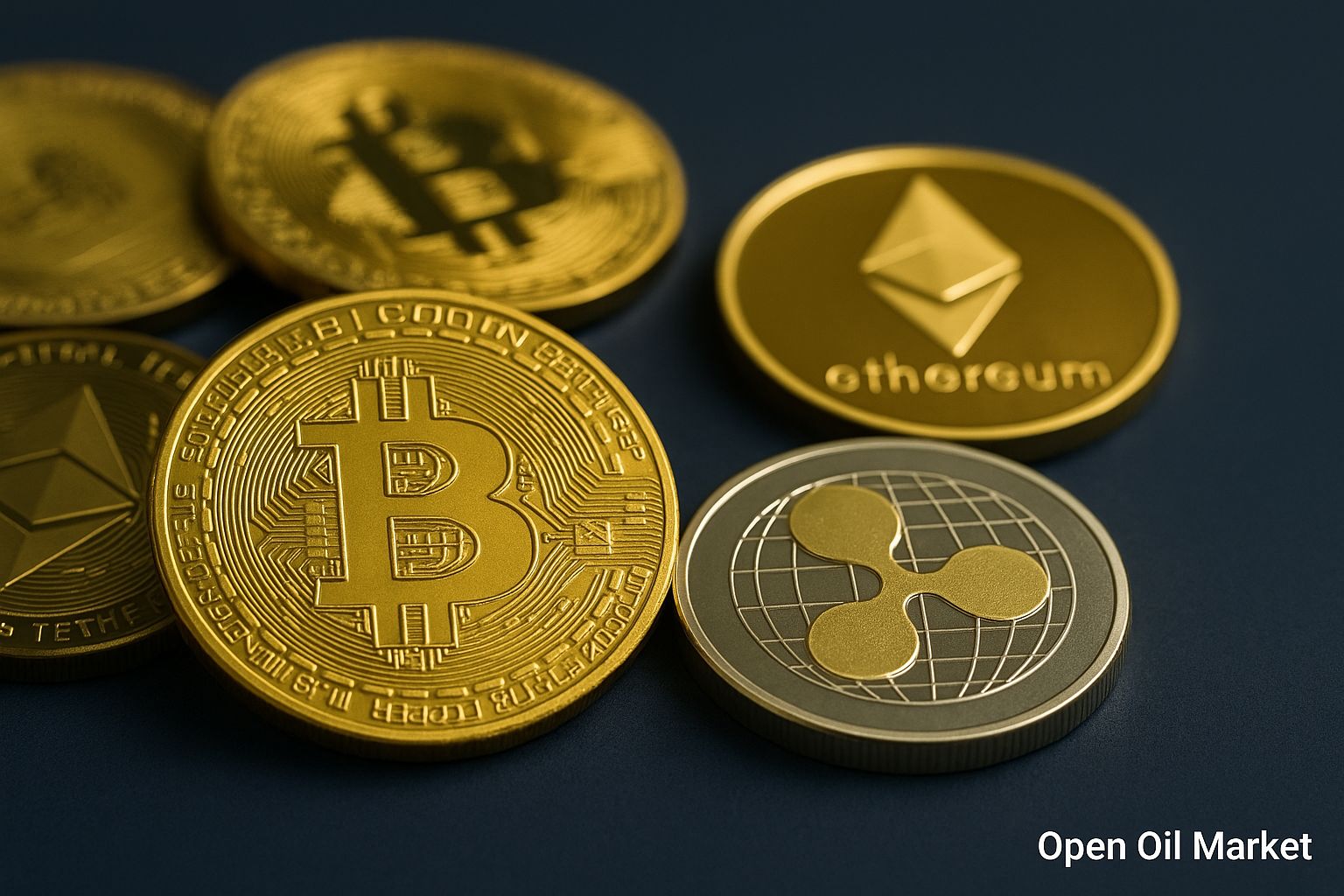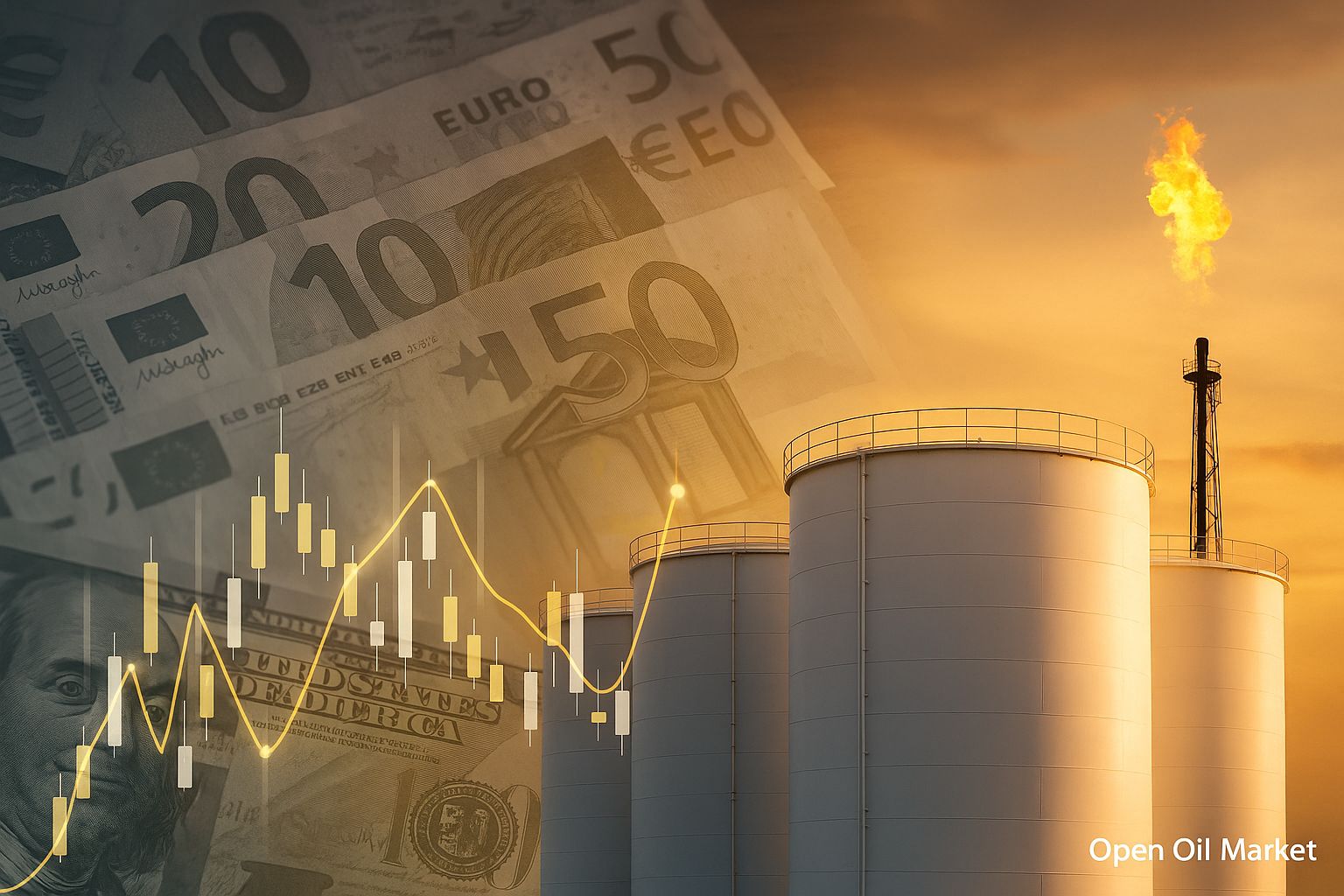
Current Cryptocurrency News as of October 21, 2025: Bitcoin Maintains Above $110,000 After Volatility, Ethereum Holds Around $4,000, Altcoins Resume Growth. Investor Sentiment Improves Amid Expectations of FOMC Policy Easing; Review – Top 10 Popular Cryptocurrencies, Institutional Trends, and Market Forecasts.
As of the morning of October 21, 2025, the cryptocurrency market is showing a confident recovery following recent volatility. Bitcoin is holding above the key mark of $110,000, regaining much of the losses experienced last week and supporting the growth of the total market capitalization (over $3.5 trillion). Following Bitcoin's lead, Ethereum and most major altcoins are strengthening: nearly all of the top 10 digital assets are trading in the "green zone." Investors—including institutional ones—are gradually returning to the market amid improved sentiment, interest in new crypto ETFs, and a favorable regulatory environment.
Bitcoin Stabilizes After Volatile Swings
The market leader, Bitcoin (BTC), has consolidated around the $110–112,000 levels as of October 21, maintaining its position after a sharp surge and subsequent correction earlier in the month. In the first week of October, Bitcoin managed to hit an all-time high, surpassing approximately $125,000 amidst the "Uptober" phenomenon and a surge of capital inflows. However, unexpected news, particularly the U.S. announcement of a 100% trade tariff on imports from China, triggered a brief "flash crash": the BTC price plummeted nearly 15%, dropping to just above $100,000 before finding support. Nevertheless, by mid-month, Bitcoin had regained much of its drop and climbed back above $110,000, confirming its resilience. The current price is roughly 2–3% below peak levels, yet significantly higher than last month’s figures; since the beginning of the year, BTC has increased about 45%, outperforming most traditional assets. Bitcoin's market capitalization is currently estimated at around $2.2–2.3 trillion, accounting for about 60% of the entire cryptocurrency market capitalization.
Despite recent fluctuations, the fundamental factors for Bitcoin remain positive. The U.S. Federal Reserve signals a readiness to ease monetary policy: recent speeches from Fed officials have reinforced expectations for a rate cut at the upcoming meeting at the end of October. The prospect of cheaper money supports demand for "digital gold" among investors. Additionally, the U.S. maintains a cryptocurrency-friendly environment—the administration continues its support for the industry, having previously allowed BTC to be included in 401(k) retirement plans and initiated the creation of a government crypto reserve. Institutional inflows are further boosting the market: the first spot Bitcoin ETF in the U.S. (launched by BlackRock) attracted over $1.5 billion in investments in its initial weeks of operation, demonstrating strong appetite from major players. Certain public companies have also taken advantage of lower prices: for instance, mining firm Marathon Digital Holdings reported purchasing around 400 BTC last week, which market participants view as a vote of confidence. Experts note that Bitcoin's solid recovery following the crash has increased trust among traders and investors: many consider the recent decline a mere technical pause within an ongoing bull trend. Major investment banks (JPMorgan, Standard Chartered, etc.) continue to hold optimistic forecasts, anticipating Bitcoin's price could rise to $150,000-$200,000 by year-end, assuming a favorable macroeconomic environment.
Ethereum and Major Altcoins
The second-largest cryptocurrency asset, Ethereum (ETH), is also demonstrating stability and gradual recovery. The price of Ethereum has reclaimed the psychologically important level of $4,000, currently fluctuating within the range of $4,050–4,100, which is about 15% below its recent peak. In early October, following Bitcoin's lead, ETH soared to approximately $4,900, hitting an all-time high for the first time in four years (the previous record of $4,890 was achieved in November 2021). After this, Ethereum corrected along with the overall market, declining about 15%, but managed to hold around the $4,000 mark, thus preserving a significant part of its previous growth. Current market capitalization for Ethereum is about $500 billion (≈13% of the market), strengthening its status as the largest altcoin.
Demand for Ethereum is supported by fundamental factors. The Ethereum blockchain remains a key platform for the decentralized finance (DeFi) ecosystem, NFTs, and numerous dApps, ensuring sustained interest in ETH even during market fluctuations. Investors are optimistic about upcoming technological updates to the network. In the coming weeks, a scheduled protocol upgrade for Ethereum (codenamed "Fusaka") is set to enhance the network's scalability and security, which could reduce fees and improve throughput. Moreover, rumors are circulating that the SEC is close to approving the first spot ETF for Ethereum—potentially occurring in this quarter—which could serve as a powerful catalyst for ETH. Institutional interest in Ethereum is also notable: open interest in ETH futures on the Chicago Mercantile Exchange (CME) hit a record level at the beginning of the month (equivalent to over $11 billion), and funds focused on Ethereum are garnering increased attention from investors. Collectively, these factors indicate the confidence of major players in the long-term potential of Ethereum despite short-term fluctuations.
Among the other leading digital coins, Binance Coin (BNB) stands out—an own token of the largest crypto exchange, Binance. In October, BNB experienced sharp price swings: after reaching a record high (above $1,300 at the beginning of the month), the token fell to around $860 during the sell-off but then rebounded strongly. Currently, BNB trades around $1,150 per coin, just slightly below its all-time high. Despite the legal and regulatory challenges surrounding Binance, BNB confidently remains in the top 5 due to its wide range of use: it is used to pay trading fees, participate in new token launches, stake, and engage in various DeFi services within the BNB Chain ecosystem.
XRP, the token for the Ripple payment network for cross-border transactions, also continues to hold its ground. XRP is currently consolidating around $2.50, having more than doubled since the start of the year. In 2025, XRP experienced a significant rally following Ripple's legal victory over the SEC in the U.S.: the court confirmed that trading XRP does not violate securities laws, removing regulatory uncertainty. This legal clarity has restored investor confidence and allowed XRP to re-enter the top five largest cryptocurrencies by capitalization (≈$140 billion). Despite recent corrections from peak levels of around $3, the Ripple token remains in high demand, continuing to be one of the key assets in the realm of payment blockchain solutions.
Altcoin Market: Solana, Cardano, and Others
The broader altcoin market is generally showing synchronized improvement along with Bitcoin and Ethereum. Solana (SOL), one of the fastest-growing platforms for smart contracts, is holding near the $190–200 range, demonstrating relative resilience. Just a week ago, SOL was underperforming compared to the market, but with the renewed activity in DeFi applications based on Solana, its price rebounded energetically. Interest in SOL is further fueled by expectations that Solana may become the next cryptocurrency to gain approval for a spot ETF launch in the U.S. If a SOL ETF is approved, Solana would be the first protocol after BTC and ETH to have its own fund in the traditional market—this would attract even more institutional attention to the coin. Additionally, the Solana ecosystem continues to develop dynamically: new DeFi platforms and NFT marketplaces are launching, enhancing the fundamental value of SOL in the long term.
Another notable altcoin is Cardano (ADA), a blockchain platform being developed with a scientific approach. ADA is currently trading around $0.68, stabilizing after sharp fluctuations in previous months. Earlier, amid rumors about an ETF launch, Cardano's price surged close to $1, but then corrected 30% from those peaks. Nevertheless, interest in the Cardano project remains high: the team continues to implement technological updates (e.g., the Hydra scalability protocol), and a vast community of supporters believes in the long-term growth potential of the ecosystem. Many ADA holders are counting on improvements in the network's technical parameters and potential launches of investment products based on Cardano to eventually help the token reach new highs.
In the top 10 cryptocurrencies by market capitalization, a variety of projects like Dogecoin and Tron are also present. Dogecoin (DOGE), the meme cryptocurrency originally created as a joke, trades around $0.18–0.20 and retains its place among market leaders. Despite a drop of over 20% in early October, DOGE quickly recovered with support from its devoted community and periodic attention from celebrities. The volatility of this coin remains high, but investor interest in the "meme" asset proves to be surprisingly resilient, allowing Dogecoin to remain in the top 10. The Tron (TRX) platform, focused on decentralized entertainment and Web3, is trading around $0.30–0.32. TRON is particularly popular in Asia, and its ecosystem attracts users with staking opportunities and low fees. Notably, a significant portion of the stablecoin USDT is issued on the Tron blockchain, creating strong demand for TRX for transactions. The presence of Dogecoin and Tron among the leaders highlights the diversity of the cryptocurrency industry: alongside high-tech platforms, investors also value niche projects focused on community and specific applications.
Institutional Trends: Cautious Optimism Returns
Mid-autumn behavior among large institutional investors in the crypto market reflects cautious optimism. On one hand, recent volatility has prompted some players to lock in profits: last week saw capital outflows from several crypto ETFs. According to industry analysts, the total net capital outflow from spot Bitcoin funds in the U.S. was around $1.2 billion, while outflows from Ethereum ETFs were approximately $300 million (partially attributed to price corrections and rebalancing positions). These figures show that some investors have temporarily reduced their risks amid price declines.
On the other hand, the strategic interest of major capital in cryptocurrencies does not wane; on the contrary, it continues to grow. In 2025, American regulators have already approved several spot exchange-traded funds for digital assets, significantly simplifying access for institutional investors to the cryptocurrency market. New ETFs on several leading altcoins, including Solana and XRP, are expected to be approved by the end of the year. The emergence of such products will expand opportunities for conservative investors to invest in cryptocurrencies through familiar exchange-traded instruments.
Additionally, the integration of cryptocurrencies into the traditional financial system continues. Major banks and fintech companies worldwide are announcing new services related to digital assets. In the U.S., several fintech banks (e.g., Brex) have begun supporting transactions in the stablecoin USDC for their clients, while some regional banks are experimenting with issuing their own stablecoins to expedite interbank payments. In the European Union, a comprehensive regulatory package, MiCA, came into force this summer, establishing clear rules for the crypto industry, and licensing for stablecoin providers has been introduced in Hong Kong—these measures globally enhance trust in the industry and attract institutions. Overall, despite short-term market fluctuations, major financial players are not withdrawing from their crypto projects. On the contrary, there is an acceleration in investments in blockchain startups and infrastructure: the corporate sector views distributed ledger technologies as one of the drivers of future growth. Thus, while a portion of funds was temporarily withdrawn from cryptocurrencies due to increased volatility, the strategic interest of institutions in digital assets remains an upward trend.
Market Sentiment and Volatility
The sharp price fluctuations at the beginning of October significantly impacted market participants' sentiments, but the situation is gradually stabilizing. Just a week ago, the "Fear and Greed Index" for cryptocurrencies plunged into the "extreme fear" zone amid panic selling—such was the shock from the sudden price crash. However, as prices have recovered, the index has regained some ground: it now stands around 45 points out of 100, which, while still corresponding to a "fear" mode, is significantly better than recent lows. One could say that the euphoria experienced at the start of the month has completely evaporated, but extreme panic is also behind us—investor sentiments are gradually shifting towards neutral.
Forced liquidation volumes on cryptocurrency derivative exchanges have also decreased to average levels. During the peak of the crash on October 10-11, positions worth a record ~$19 billion were liquidated (impacting more than 1.5 million traders), whereas in recent days, exchanges have only been forcing liquidations worth hundreds of millions of dollars daily. This indicates that the market has shed a significant portion of excessively risky and over-leveraged positions, easing the pressure from margin calls. Experts note that such a "cleaning" from excess leverage could be healthy for the market: the removal of overheated speculative positions lays a more solid foundation for future growth.
Nevertheless, market participants should still be prepared for elevated volatility. Geopolitical factors—for instance, the escalation of trade disputes between the U.S. and China—can trigger a new wave of price fluctuations in risk assets at any moment. Additionally, important events are ahead that the crypto community is monitoring: central bank decisions regarding rates, the publication of macroeconomic data, and potential regulatory statements. Any surprises in these areas could either accelerate a new rally or provoke another wave of correction. In the short term, the market will likely continue to alternate between growth and pullback phases as news is digested; however, in the absence of new shocks, the fundamental optimism among investors remains intact.
Forecasts and Expectations
Despite recent fluctuations, many analysts maintain a positive outlook on the cryptocurrency prospects for the remainder of 2025. The overall bullish sentiment is supported by expectations for monetary policy easing soon: if the U.S. Federal Reserve indeed begins to lower interest rates, this could lead to a new influx of capital into high-yield asset markets—including Bitcoin and Ethereum. Several investment firms have raised their price targets in October: some major banks forecast Bitcoin could rise to $150,000-$180,000 in the next 3-6 months. For Ethereum, optimistic scenarios suggest a move towards $6,000 and higher, especially if the ETF is successfully launched and the network's technological updates are realized.
However, conservatively minded experts caution that the path to new peaks may be uneven. After such a powerful rally, further spikes in volatility are possible, especially as Bitcoin's price approaches psychologically significant levels (e.g., $130,000 and $150,000). In case of a deterioration in the geopolitical situation or delays in rate cuts, the market might enter a prolonged flat phase or deepen its correction. Nevertheless, historical experience shows that every significant downturn in the crypto market eventually gives way to a new growth cycle. Investors are advised to adhere to risk management principles: diversify their portfolios, avoid excessive leverage, and not succumb to emotions during panic sell-offs. The cryptocurrency sector still possesses strong fundamental growth drivers—and under favorable macro conditions, many specialists expect the market to conclude the year on a positive note, possibly setting new historical highs.
Top 10 Most Popular Cryptocurrencies
As of the morning of October 21, 2025, the top ten largest and most popular digital assets by market capitalization are as follows:
- Bitcoin (BTC) – the first and largest cryptocurrency, serving as an analogue to "digital gold." BTC trades near $111,000, remaining close to its record values. Bitcoin's market cap exceeds $2.2 trillion (around 60% of the total market), and it continues to set the tone for market dynamics.
- Ethereum (ETH) – the second-largest crypto asset and the primary platform for smart contracts, DeFi, and NFTs. ETH costs approximately $4,100, a bit lower than its all-time high (≈$4,900). Ethereum's market valuation is about $500 billion (≈13% of the market). Ethereum is undergoing active development to enhance scalability, supporting long-term investor interest.
- Binance Coin (BNB) – the exchange token of the largest crypto exchange, Binance, and the native coin of the BNB Chain ecosystem. The current price of BNB is around $1,150. In October, the token set a new high (≈$1,300) and remains in the top 3 due to its wide range of applications (fee payments, DeFi participation, etc.). The market capitalization of BNB is estimated at about $170–180 billion.
- Tether (USDT) – the largest stablecoin pegged to the U.S. dollar on a 1:1 basis. USDT is widely used for trading and transactions on crypto exchanges. Its price is maintained at $1.00 (≈80 ₽), with a market cap of around $160–170 billion. USDT plays a critical role in the ecosystem, providing liquidity and hedging risks.
- XRP (Ripple) – the token for the Ripple payments platform for cross-border transfers. XRP is trading around $2.50; with a market cap of approximately $140 billion, it is firmly positioned among the leading market assets. Ripple's success in court against the SEC has eliminated regulatory uncertainty surrounding XRP, boosting investor confidence. The token remains one of the essential assets in the global payments realm.
- Solana (SOL) – a high-performance blockchain platform for decentralized applications. SOL is priced around $190 per coin (market cap ~ $90–100 billion), having rebounded following a recent correction. Solana attracts attention with its scalability and the growth of its ecosystem, alongside expectations for launching its ETF, which supports its position in the top ten.
- USD Coin (USDC) – the second-largest stablecoin backed by dollar reserves (issued by Circle). USDC's price is tightly pegged to $1.00, with a market capitalization of around $65 billion. USDC is popular among institutional investors and in DeFi due to its transparency regarding reserves and regulation, ensuring its vital role in trading and payment operations.
- Dogecoin (DOGE) – the most recognized meme cryptocurrency, created for fun. DOGE hovers around $0.19 (market capitalization ~ $28 billion) following a retreat from September highs. The coin remains sought after due to its loyal community and periodic media mentions. Despite high volatility, Dogecoin continues to rank among the top ten cryptocurrencies, showing remarkable resilience in investor interest.
- Cardano (ADA) – a smart contract platform that is being developed with a research-based approach. ADA is trading around $0.68 (market capitalization ~ $25 billion) after correcting from recent peaks near $1. The project draws attention with planned technological updates and a potential ADA-based ETF launch. An active community and technological improvements support Cardano's long-term outlook.
- TRON (TRX) – a blockchain platform for creating decentralized applications and digital entertainment, notably popular in Asia. TRX is trading around $0.32; the market capitalization is estimated at approximately $30 billion. TRON is known for its wide utilization of its network for issuing stablecoins (a significant portion of USDT operates on Tron) and staking capabilities, providing steady demand for the token. The project continues to develop its Web3 ecosystem, maintaining its position among market leaders.
The Cryptocurrency Market as of October 21, 2025
- Prices of Major Cryptocurrencies: Bitcoin (BTC) — $111,000; Ethereum (ETH) — $4,050; XRP — $2.50; BNB — $1,130; Solana (SOL) — $190; Cardano (ADA) — $0.68.
- Market Metrics: total cryptocurrency market capitalization ≈ $3.8 trillion; Bitcoin's share ≈ 59–60%; fear and greed index = 45 (fear zone, improvement compared to the previous week).
- Leaders in Daily Change: Growth – Synthetix (SNX) +20%; Decline – Myx Finance (MYX) –7%.
- Analysis: Bitcoin and Ethereum are consolidating around current levels after turbulent trading, indicating relative market calm. While the sentiment index remains in the fear territory, it has significantly increased from extreme values—panic sentiments have subsided, and investors have taken a wait-and-see position. The leading growth is seen in the DeFi protocol token SNX, attracting attention with a sharp daily spike—indicative of localized interest in altcoins amid the general recovery. The 7% price drop of MYX reflects targeted profit-taking on less liquid assets following a recent rally. Overall, the cryptocurrency market demonstrates resilience: key metrics remain healthy, and investor interest is gradually returning. This creates a solid foundation for a potential new rally following the consolidation phase, provided external conditions remain favorable.




